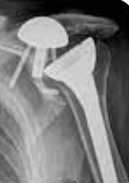Here are some cases of failure of the baseplate fixation to the scapula in reverse total shoulders performed with several different modern prosthesis systems. What do these failures have in common?
The ability of the glenoid component to resist these major loads depends on (1) secure bony fixation of the inferior screws in bone (green arrows) to resist failure in traction and (2) compression of the superior aspect of the baseplate against glenoid bone (yellow arrow) to prevent its rocking upwards as pointed out in Factors affecting fixation of the glenoid component of a reverse total shoulder prothesis.
If either of these is insecure, upward loads on the glenosphere can cause the baseplate to rock upwards away from the bone.
It's all about good carpentry: (1) preparing the glenoid bone so that there is maximal contact between the superior baseplate and host bone and (2) secure screw placement in good quality bone. If the quality of the bone suboptimal, insertion of the baseplate central screw without tapping may provide better fixation (see Avoiding Glenoid Baseplate Fixation Failure by Altering Surgical Technique for Varying Bone Densities).
Bone graft may not be a perfect substitute for host bone; see Early radiographic failure of reverse total shoulder arthroplasty with structural bone graft for glenoid bone loss
The authors of How to Avoid Baseplate Failure: The Effect of Compression and RSA Baseplate Design on Implant Stability recognize that immediate, secure fixation of the baseplate is essential: patients may fall or otherwise load the glenosphere soon after surgery - long before any ingrowth has taken place. Furthermore, high compression of the central screw dramatically improves the initial (T=0) stability of the baseplate.
In Revision Reverse Shoulder Arthroplasty for the Management of Baseplate Failure: An Analysis of 676 Revision RSA Procedures the importance of maximizing the contact between the baseplate and supporting bone is again emphasized for both primary and revision reverse total shoulders.
Finally, the stability of the baseplate on the bone of the glenoid is optimized by inferior inclination of the glenosphere, which results in a compressive force on the baseplate against bone when the glenoid is loaded by the humerus (note the obtuse angle between the arrows)
...as opposed to the distracting force that results when the glenosphere is superiorly inclined (note the acute angle between the arrows). (see Biomechanical comparison of component position and hardware failure in the reverse shoulder prosthesis)
It's about good carpentry
You can support cutting edge shoulder research that is leading to better care for patients with shoulder problems, click on this link.
Follow on twitter: https://twitter.com/shoulderarth
Follow on facebook: click on this link
Follow on facebook: https://www.facebook.com/frederick.matsen
Follow on LinkedIn: https://www.linkedin.com/in/rick-matsen-88b1a8133/
Here are some videos that are of shoulder interest
Shoulder arthritis - what you need to know (see this link).
How to x-ray the shoulder (see this link).
The ream and run procedure (see this link).
The total shoulder arthroplasty (see this link).
The cuff tear arthropathy arthroplasty (see this link).
The reverse total shoulder arthroplasty (see this link).
The smooth and move procedure for irreparable rotator cuff tears (see this link).
Shoulder rehabilitation exercises (see this link).
Follow on twitter: https://twitter.com/shoulderarth
Follow on facebook: click on this link
Follow on facebook: https://www.facebook.com/frederick.matsen
Follow on LinkedIn: https://www.linkedin.com/in/rick-matsen-88b1a8133/
Here are some videos that are of shoulder interest
Shoulder arthritis - what you need to know (see this link).
How to x-ray the shoulder (see this link).
The ream and run procedure (see this link).
The total shoulder arthroplasty (see this link).
The cuff tear arthropathy arthroplasty (see this link).
The reverse total shoulder arthroplasty (see this link).
The smooth and move procedure for irreparable rotator cuff tears (see this link).
Shoulder rehabilitation exercises (see this link).











